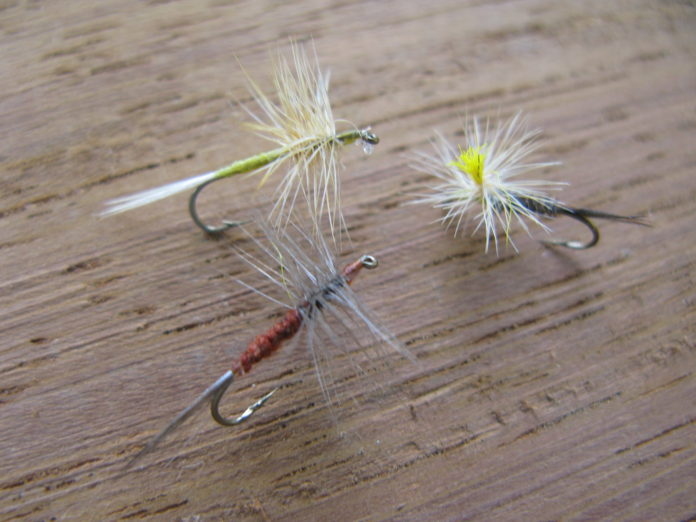By TONY BONAVIST
As most of you know, if you have followed this column since its inception, I’ve a been a big fan of the Rusty Spinner dry fly.
In fact, I wrote a column about the fly for the June 15 edition of the River Reporter.
For years, as evening approached and spinner falls began, I immediately attached a Rusty Spinner to my tippet. It was my go-to pattern for late evening fishing, and I had excellent results as I used it over the years. I became so confident in the Rusty Spinner that once I found a steadily feeding trout, I would rise it. The fly seldom let me down.
More recently, when other imitations failed, during mayfly hatches I tried the Rusty Spinner, just to see whether or not it would work. Much to my surprise, I began to catch trout during the various mayfly hatches, when imitations of the mayfly duns failed.
At first, I did not pay a lot of attention to the fact that I was rising trout on a Rusty Spinner, during daytime mayfly hatches, even when there were no spinners on the water. Then about a month ago, we went looking for the remnants of the green drake hatch. It was along the lower reaches of the river, where we seldom fish. I chose a section close to the access path, which I believe held trout, but was seldom fished. We arrived about 5:30 a.m., saw few rises, but no flies on the water. Since we were at the end of the green drake hatch, and there were still a few spinners around, I decided to try a Coffin Fly. The Coffin Fly is an imitation of the spinner stage of the green drake, tied on a number 10 hook. Over a period of two hours, I landed three very nice browns and one rainbow on that fly! None of the smaller flies I tried worked, even though the trout were feeding on insects that were not visible on the surface.
More recently during a very large Sulphur mayfly hatch, coming off a Catskill tailwater, I had absolutely no results while using a traditional size 18 imitation of a sulphur dun. So for the heck of it, I tied a number 16 Rusty Spinner and began to cast to the closest rising trout. It was a fairly short cast, and if my memory serves me correctly, that fish took on the second cast. It was a beautifully colored wild brown.
About a week later, along another reach of the same river, I was fortunate enough to find another large sulphur hatch. And despite repeated casts, rising trout once again ignored my traditional sulphur imitation. So I attached a size 16 Rusty Spinner to my tippet, and over the course of the next two hours, rose six or seven trout, and landed four.
About a week later, fishing the Lower Camp Pool, near where we keep our RV; I once again found a large sulphur hatch. At the time, there were several trout taking the little duns, while others fed on emerging flies. As a test, I tied on a size 18 Sulphur Dun to see if it would bring a rise or two. I don’t know how many casts I made with that little fly, but not one trout came to it. So as a test, I decided to try a spinner, but this time, a Pale Evening Dun, size 16. Within five minutes, a nice trout rose to the fly and was quickly lost. A little later, I moved up to the head of the pool, and found a trout taking flies immediately across from where I was wading, but near the far bank. I made a few casts, and soon landed very nice, beautifully colored wild brown.
On August 7, we decided to fish the Lower Camp Pool again. When we arrived and waded in, there were thousands of sulphurs on the water, but no trout rising. Then about 15 minutes later, the first rise forms began. Whenever I’m fishing and mayfly duns are on the water, I watch those duns to see if trout are actually taking off the surface or taking emergers. In this case, and all too often, trout feed on the nymphs or hatching flies on or near the surface. Over the many years that I’ve encountered this kind of feeding behavior, I’ve had very little success catching trout. But this year, on a whim, I began tying what I call the “parachute pheasant tail nymph.” It’s designed so that the nymph floats in the surface film, where it appears that much of the feeding takes place.
I’m delighted to report that I had at least five trout come to that little fly. I’m not sure I’m onto a solution or whether this was a one-time result. I believe I’ll find out the answer, during the next sulphur hatch.
The question? Why are trout, that are feeding on mayfly duns, refusing well tied imitations, yet take a spinner? The only answer I have is that spinners and my little parachute pheasant tail nymph float in the surface film, are easier to see and look more natural, than traditional dun imitations. I‘ve had enough success fishing these types of flies throughout the years to know that they work when other patterns do not. So as long as they produce, I’ll continue to fish those patterns, unless I learn otherwise.
Credit: Source link































